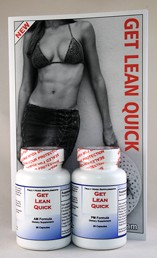
Click Here For Free Diet And Fitness Magazine Subscription
Exercises
Weight-bearing & non weight-bearing - walking - dancing - stretching - water - yoga - tai chi
Featured Product Get Lean Quick 14 Day Fat Loss Click here! |
Easy Exercises
If you are very overweight, or if your feet or joints hurt when you stand, then it's likely that non weight-bearing activities will be best for you. Non-weight-bearing activities, like swimming, put less stress on your joints because you don't have to lift or push your own weight.
1. Walking (weight-bearing)
The walking that you do during the day (when doing chores around the house or in the yard) can help you be more fit. But regular, steady walking that makes you breathe heavier can help you to be healthier. It will give your heart and lungs - as well as your leg muscles - a good workout.
If you are not active now, start slowly.
Try to walk 5 minutes a day for the first week.
Walk 8 minutes the next week.
Stay at 8-minute walks until you feel comfortable.
Then increase your walks to 11 minutes.
Slowly lengthen each walk by 3 minutes, or walk faster.2. Dancing (weight-bearing or non-weight-bearing)
Dancing helps:
- Tone your muscles
- Improve your flexibility
- Make your heart stronger
- Make your lungs work better
You can dance in a health club, in a nightclub, or at home. To dance at home, just move your body to some lively music!
Non weight-bearing dancing
Dancing on your feet is a weight-bearing activity.
Dancing while seated lets you move your arms and legs to music while taking the weight off your feet. This may be a good choice if you can't stand on your feet very long.3. Water Workouts (non-weight-bearing)
Exercising in water helps you feel:
Flexible
You can bend and move your body in water in ways you can't on land.
Strong
Working against the water will help your body get stronger.
At less risk of injury
Water makes your body float. This keeps your joints from being pounded or jarred and helps prevent sore muscles and injury.
Refreshed
You can keep cooler in water-even when you are working hard.
Note: You don't need to know how to swim to work out in water-you can do shallow-water or deep-water exercises without swimming.For shallow-water exercise
The water level should be between your waist and your chest. If the water is too shallow, it will be hard to move your arms underwater. If the water is deeper than chest height, it will be hard to keep your feet touching the pool bottom.For deep-water exercise
Most of your body is underwater. This means that your whole body will get a good workout. For safety and comfort, wear a foam belt or life jacket.Many swim centers offer classes in water workouts. Check with the ones in your area to find the best water workout for you.
4. Stretching (weight-bearing or non-weight-bearing)
Stretching helps:
- Make you more flexible (to help keep you from getting hurt)
- Make you feel relaxed
- Improve your blood flow
- Keep your muscles from getting tight after doing other exercises.
You don't have to set aside a special time or place to stretch. At home or at work, stand up, push your arms toward the ceiling, and stretch. Stretch slowly and only enough to feel tightness - not until you feel pain. Hold the stretch, without bouncing, for about 30 seconds. Don't stretch cold muscles
Yoga and Tai Chi are types of stretching
They help you breath deeply, relax, and get rid of stress.Please note: If you can do only a few or none of these activities, it's OK. Remember to appreciate what you can do, even if you think it's a small amount. Just moving any part of your body, even for a short time, can make you healthier.
Click Here For Free Diet And Fitness Magazine Subscription
[Home] [Dieting Tips] [Weight Loss Diet Advice] [Weight Loss Issues] [Obesity Issues] [Exercise] [Weight Loss Pills] [Links]
© Copyright 2001-2021 Weight Loss Diet Information
Terms of Use
The material on this site is provided for general educational and general informational purposes only. It is not intended to be, and should not be considered to be, any form of substitute for medical counseling. Always consult your own doctor or health care provider about the suitability of any opinions or recommendations with respect to your own symptoms or medical conditions. If you are currently on a medically prescribed diet or have any specific medical conditions, food allergies or intolerances which require you to be on one, you must consult your doctor before following any advice on this site. If you have any doubts whatsoever, then for the sake of your health please consult your doctor.